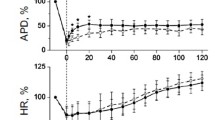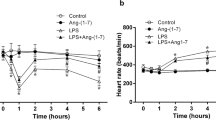Abstract
Effects of a selective thromboxane synthetase inhibitor, (E)-3-[4-(1-imidazolylmethyl) phenyl]-2-propenoic acid hydrochloride monohydrate (OKY-046), were studied hemorheologically in endotoxin shocked-rabbits. The animals were intravenously administrated with 0.1 mg of endotoxin 3 times at intervals of 3 days. At 7 days after the last endotoxin injection, endotoxin (0.2 mg·kg−1) was intravenously administrated to induce a shock. OKY-046 (30 mg·kg−1) was administrated after hypotension was developed by the endotoxin treatment and, then, it was continuously injected at 0.03 mg·kg−1·min−1. Blood pressure remained unchanged and hypotensive was maintained during the treatment with OKY-046. Blood was sampled from the femoral artery 15 (before the administration of OKY-046), 45, and 120 minutes after the final administration of endotoxin. Pao2 increased, and PaCO 2, arterial pH, and base excess (BE) decreased during the endotoxin shock. The decrease of pH and BE was prevented by the administration of OKY-046. In the endotoxin-shocked animals, hematocrit, whole blood viscosity, erythrocyte deformability, plasma fluidity, and the ratio of hematocrit to whole blood viscosity showed no significant differences between the OKY-046 treated animals and non-treated ones. These data show that a selective thromboxane synthetase inhibitor (OKY-046) does not improve the blood rheology during endotoxin shock, although it seems to prevent the acidosis in some extent.
Similar content being viewed by others
References
Chien S: Haemorheology in disease: pathophysiological significance and therapeutic implications. Clin Hemorheol 1:419–442, 1981
Chien S: Blood rheology in myocardial infarction and hypertension. Biorheology 23:633–653, 1986
Low GDO: Blood rheology in arterial disease. Clin Sci 71:137–146, 1986
Thijs LG, Teule GJJ, Bronsveld W: Problems in the treatment of septic shock. Resuscitation 11: 147–155, 1984
Czer LSC, Shoemaker WC: Optimal hematocrit value in critical ill postoperative patients. Surg Gynecol Obstet 147:363–368, 1978
Sugiura Y, Kato T, Goto Y, Yamamoto K, Aochi O: Microcirculatory and blood rheological effects of pentoxifylline in endotoxin shock. Masui (Jpn J Anesthesiol) 32:435–441, 1983
Puranapanda V, Hinshaw LB, O’rear EA, Chang ACK, Whitsett TL: Erythrocyte deformability in canine septic shock and the efficacy of pentoxifylline and a leukotriene antagonist. Proc Soc Exp Bio Med 185:206–210, 1987
Muller R, Musikic P: Hemorheology in surgery — a review. Angiology 38:581–592, 1987
Herman AG, Vane JR: Release of renal prostaglandins during endotoxin-induced hypotension. Eur J Pharmacol 39:79–90, 1976
Lefer AM: Role of the prostaglandinthromboxane system in vascular homeostasis during shock. Circ Shock 6:297–303, 1979
Cook JA, Wise WC, Halushka PV: Elevated thromboxane levels in the rat during endotoxic shock. Protective effects of imidazole, 13-azaprostanoic acid, or essential fatty acid deficiency. J Clin Invest 65:227–230, 1980
Wise WC, Cook JA, Halushka PV, Knapp DR: Protective effects of thromboxane synthetase inhibitors in rats in endotoxin shock. Circ Res 46:854–859, 1980
Jacobs ER, Soulsby ME, Bone RC: Ibuprofen in canine endotoxin shock. J Clin Invest 70:536–541, 1982
Fukumoto S, Tanaka K: Protective effects of thromboxane A2 synthetase inhibitors on endotoxin shock. Prostaglandins Leukotrienes and Medicine 11:179–188, 1983
Kubo K, Kobayashi T: Effects of OKY-046, a selective thromboxane synthetase inhibitor, on endotoxin-induced lung injury in unanesthetized sheep. Am Rev Respir Dis 132:494–499, 1985
Tempel GE, Cook JA, Wise WC, Halushka PV, Corral C: Improvement in organ blood flow by inhibition of thromboxane synthetase during experimental endotoxic shock in the rat. J Cardiovasc Pharmacol 8:514–519, 1986
Ball HA, Cook JA, Wise WC, Halushka PV: Role of thromboxane, prostaglandins and leukotrienes in endotoxic and septic shock. Intensive Care Med 12:116–126, 1986
Burnier M, Waeber B, Auber JF, Nusseberger J, Brunner HR: Effects of nonhypotensive endotoxemia in conscious rats: role of prostaglandins. Am J Physiol 254: H509-H516, 1988
Dowd PM, Kovacs lB, Bland CJH, Kirby JDT: Effect of prostaglandins I2 and E1 on red cell deformability in patients with Raynaud’s phenomenon and systemic sclerosis. Br Med J 283:350, 1981
Iizuka K, Akahana K, Momose D, Nakazawa M: Highly selective inhibitors of thromboxane synthetase. 1. imidazole derivatives. J Med Chern 24:1139–1148, 1981
Watanabe C: Clinical and experimental study of immunological mechanisms in sepsis and septic shock. J Jpn Surg Soc 81: 365–380, 1980
Kikuchi Y, Arai T, Koyama T: Improved filtration method for red cell deformability measurement. Med & Bio Eng & Comput 21:270–276, 1983
Anegawa T, Shio H, Yasuda Y, Fujimoto N, Kameyama M: Propriety of nuclepore filter and a nickel mesh for the measurement of erythrocyte filterability. Proc J ap Soc Biorheol 9:35–38, 1986
Kato T, Takamizawa K, Hayashi K: Hemorheological changes by endotoxin shock in rabbits: a new model based on general Shwartzman phenomenon. Proc Jap Soc Biorheol 9:71–74,1986
Fletcher JR, Ramwell PW: The effects of prostacyclin (PGI2 ) on endotoxin shock and endotoxin-induced platelet aggregation in dogs. Circ Shock 7:299–308, 1980
Smith ME, Holcroft JW, Demling RH: Prostaglandin E1 and prostacyclin infusion decrease thromboxane production in endotoxin-induced lung injury. J Surg Res 32:283–288. 1982
Gerner M, Hayes JA, Ishikawa S, Cuevas P, Hirsch EF: Functional and structural changes in the lungs of rabbits with endotoxemia. Surg Gynecol Obstet 137:975–979, 1973
Kato T, Takamizawa K, Hayashi K: Influence of thromboxane on the stiffness and contractility of arterial wall in endotoxinshocked rabbits. Masui (Jpn J Anesthesiol) 36:S87, 1987(abstract)
Kato T, Goto Y, Yoneda S, Yamamoto K, Aochi O: Effects of prostaglandin I2 and a selective thromboxane synthetase inhibitor on the arteriolar constriction caused by norepinephrine. Angiology 41:589–594, 1990
Author information
Authors and Affiliations
About this article
Cite this article
Kato, T., Hayashi, K., Takamizawa, K. et al. A selective thromboxane synthetase inhibitor, OKY-046, fails to improve blood rheology in endotoxin-shocked rabbits. J Anesth 5, 247–254 (1991). https://doi.org/10.1007/s0054010050247
Received:
Accepted:
Issue Date:
DOI: https://doi.org/10.1007/s0054010050247




